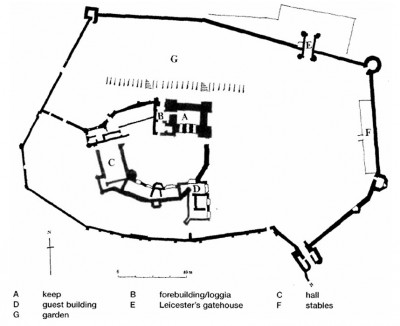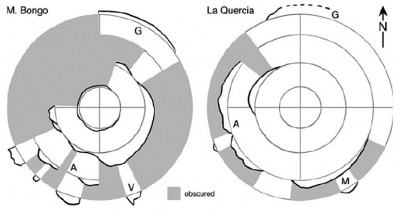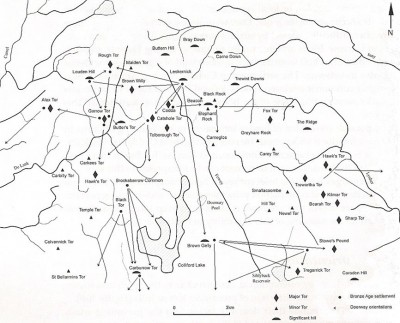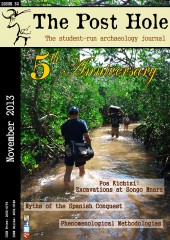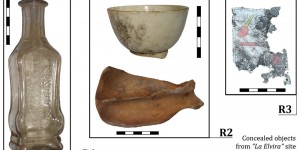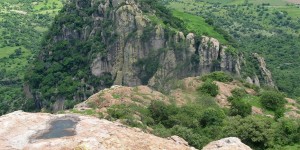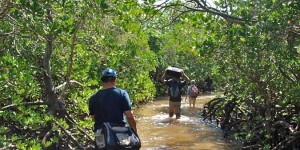"Narrative is a means of understanding and describing the world in relation to agency. It is a means of linking locales, landscape, actions, events and experiences together providing a synthesis of heterogeneous phenomena. In its simplest form it involves a story and a story-teller" (Tilley 1994, 32).
This statement encapsulates the central interpretive methodology of phenomenological approaches in archaeology: the narrative. Strongly influenced by the development of post-processual ideas throughout the 1980s and 90s, Tilley presented ‘the narrative’ as an alternative to conventional methodologies focusing on the primacy of empirical data. In the same year as Tilley’s (1994) publication, Gosden’s (1994) Social Being and Time contributed to a phenomenological understanding of landscape through a consideration of the perceptual nature of the temporal framework of human action. From these beginnings, several applications of the theory were published, from Edmond’s (1999) consideration of Neolithic landscapes through phenomenology to non-prehistoric case studies (e.g. Johnson 2002) to a more rigorous and methodologically confident approach in the mid-2000s (Cummings and Whittle 2004; Hamilton et al. 2006; Bender et al. 2007). Throughout the development of the theory, a series of methodological approaches have taken phenomenological interpretations beyond the subjectively constructed narrative. Perhaps unsurprisingly, phenomenology has had its share of critics, most notably Fleming (1999, 2005, 2006) who took issue with a lack of reference to the material evidence in its interpretations. Whilst many of Fleming’s criticisms were valid, I will demonstrate through a consideration of the changing approaches, that phenomenological methodologies still have great potential for contributing to our understanding. Furthermore, I will consider how future methodologies might better integrate phenomenological approaches with material evidence in order to move towards a more nuanced understanding of past landscapes.
To understand phenomenological approaches in archaeology, we must first understand the basic suppositions of the form of phenomenology on which they are based, namely that of Heidegger. Heidegger’s philosophy stipulates that, as social actors in the world, everything that constitutes our conscious self is intricately tied to both our social interactions and our perpetual physical environment. Thus, rather than referring to the self or subject, he uses the term ‘Dasein’ (literally ‘being-there’) to refer to the human entity (Heidegger 1962, 27).
"The kind of Being which belongs to Dasein is rather such that, in understanding its own Being, it has a tendency to do so in terms of that entity towards which it comports itself proximally and in a way which is essentially constant—in terms of the ‘world’." (Heidegger 1962, 36).
Because our physical setting (the world) is constant, it forms the base line of all human ‘being’ and by extension knowledge, perceptions and understanding. Phenomenological approaches in archaeology, therefore attempt to understand the past through an experiential study of sites and landscapes, rather than synthesising them into units of divisible data for analysis. These approaches also take issue with an over-emphasis on social factors. Gosden’s (1994) critique of structuralism, post-structuralism and hermeneutics suggests that through a focus on the internal logics and meanings of social interaction these approaches ‘ignore the relationship of people to the world’ (Gosden 1994, 45). From the outset, phenomenological archaeology attempted to create a model of understanding which could characterise the entire human experience and would not be constrained by positivism or restrictive social models.
Maps are a mainstay of almost any study in landscape archaeology, as they graphically represent landscape features in a spatially logical manner. However, Tilley’s (1994) approach to the landscape was one focused on perceived space rather than absolute space, so he saw maps as removing ‘the operations and practices which constitute places and locales’ (Tilley 1994, 32). Instead he tried to understand the landscape by considering the location and orientation of sites in relation to each other. His approach to understanding British prehistoric landscapes entailed an application of ethnographic case studies from around the world as analogies for spatial perception. The totemic geography ascribed to the various formations of Ayers rock (Figure 1) given as a particularly rich example of a mythological landscape.
When applied to British prehistory, the focus is on trying to understand the visual interconnections between sites in the landscape. Tilley comments on how the megaliths of South-West Wales seem to make symbolic reference to what were named features in the landscape (Tilley 1994, 109) and how the Dorset Cursus connects monuments in the landscape sequentially to create a ‘spatial story’ (Tilley 1994, 199). Whilst at times it seems highly subjective, in many ways this approach was a first step in the formation of a bridge between traditional micro-level site analysis and macro-level landscape analysis.
Following on from Tilley’s research, several publications took the phenomenological method of the narrative further. Edmond’s (1999) monograph Ancestral Geographies of the Neolithic looks at a similar set of landscapes to Tilley. A central aim of the book was to capture the ‘humanity and materiality’ of life in the Neolithic (Edmonds 1999, ix) which Edmond saw to be lacking in the literature up to that point. His solution to this issue was to give a voice to past peoples and use this device to convey the material evidence:
“Our first world was the forest, but before the forest there was ice. There was no colour and no time, no smoke and no tracks. The land was barren.” (Edmond 1999, 11).
This characterisation of people of the past through narrative opened up new ways of structuring and interpreting the evidence. Subsequent work in the 21st century, much of which would not identify itself with phenomenology, has frequently integrated this narrative characterisation into their methods for approaching the evidence. For example, Mithen (2003) follows John Lubbock as he visits people and landscapes throughout the Holocene, and Diamond (2005) paints vivid narratives of the ‘collapse’ of civilisations from the Easter islanders to the Greenland Norse. Despite its prehistoric beginnings, phenomenology soon found many more diverse applications. Johnson applied narrative approaches to investigate medieval castles in Agency in Archaeology (2000) and Behind the Castle Gate (2002). Kenilworth Castle (Figure 2) features heavily in both as an example of a complex sensory landscape.
By utilising a combination of architectural and documentary evidence, Johnson demonstrates how the various features of the landscape fulfilled intentional effects on their beholders. For example, making use of a document recording Elizabeth I’s visit in 1575, Johnson shows how certain features such as the archaic style of the gatehouse (Figure 2.E) and the vernacular styled stable block (Figure 2.F) constituted a landscape contrived to exude the values of Protestant chivalry (Johnson 2002, 157). This later period example demonstrates that with the benefit of documentary evidence, we can better appreciate the intentionality of phenomena in the landscape. Furthermore, it serves to strengthen the credibility of phenomenological methodologies in periods with less contextual information.
Since the work of Tilley (1994) and Gosden (1994), phenomenological archaeologies have come a long way and recent fieldwork shows a dedication to more rigorous methodologies. Cummings and Whittle (2004) brought a series of new approaches to the megaliths of South Wales. The landscapes were first recorded panoramically through circular sketch diagrams and photography then plotted using GIS, which allowed the production viewshed maps (Cummings and Whittle 2004, 17). Thus, on-site observations were not only reproduced in a somewhat standardised format but they could, to some degree, be tested against geographical data. In order to demonstrate the intentionality of the site locations, a number of ‘control’ points around the sites were analysed using GIS. This technique served to reinforce interpretations in some cases – but not consistently, as both the accuracy of the software and access to some locations proved problematic (Cummings and Whittle 2004, 21). While the authors acknowledge the limitations of their methodology: "GIS simply cannot, at present, replicate the experience of being in the landscape" (Cummings and Whittle 2004, 22) but it was clearly an invaluable step in the right direction.
Hamilton et al. (2006) conducted a phenomenological survey of Neolithic enclosures on the Tavoliere Plain, Italy. The project marked a refinement of rigorous methodologies as well as introducing new approaches. Circular view diagrams are presented in a more regularized fashion, facilitating cross-comparison (Figure 3). The diagrams explicitly represent the landscape as it is perceived and have no relation to absolute distances (Hamilton et al. 2006, 42).
The transmission of sight and sound at an intra-site level was tested through the placement of flags and people at site features and perimeters. The participants recorded the inter-visibility of major and minor gestures (e.g. arm waves and hand waves) and the inter-audibility of different sounds (e.g. speech, shouts, bells) across the enclosures (Hamilton et al. 2006, 46 – 9). For a wider conceptualization of the landscape, an adaptation of Higgs’ (1972) site catchment analysis was applied, in which traditional observations such as soil type and maximum travel distance were made, alongside perceptual observations of site visibility which were described in terms of ‘left, centre and right’ rather than cardinal points (Hamilton et al. 2006, 55 – 58). Through this method and those mentioned above, the authors demonstrated an appreciation of the subjectivist criticisms levelled against phenomenology. By integrating phenomenological methods into a more traditional mode of investigation, Hamilton et al. set an example for a new, more rigorous phenomenology of landscape.
The critique of phenomenology has developed in tandem with the changing methodological approaches of this relatively new theoretical framework. Fleming (1999) identified some serious failings in Tilley’s (1994) approach. The recording of directional axis and visibility/invisibility of monuments is criticised as highly subjective and open to a broad degree of interpretation (Fleming 1999, 120). Furthermore, Tilley is criticised for failing to consider the effect of ephemeral features in the landscape, such as trees, and his ethnographically based interpretations are criticised as ‘a limited selection of the possibilities…unconvincing in terms of the archaeological record’ (Fleming 1999, 123). Fleming’s second critique came in 2005 following Cumming’s and Whittle’s (2004) publication. The subjectivity of site inter-visibility and the graphic recording of such instances are both identified as impossible to replicate in the field (Fleming 2005, 922). Moreover, Fleming attacks the narrative approach more directly, calling it ‘a post-modern critique and interpretive writing’ which fails to be ‘investigative’ (Fleming 1999, 931). I believe this is where Fleming goes too far in his criticisms, demoting phenomenological interpretations below the level of others. Phenomenology is nothing if not investigative, but unlike traditional methodologies its investigations are rooted in experiential practice rather than analytical empiricism. Fleming’s point is elaborated in his publication of the following year in which he criticizes the post-processual ‘rejection of long-accepted modes of fieldwork’ (Fleming 2006, 267). This criticism is true of the earlier works but demonstrates a lack of appreciation for the development and refinement of methodologies evident in the work of Cummings and Whittle (2004), which led to the inception of new approaches as presented by Hamilton et al. (2006).
Brück’s (2005) critique raised a more difficult epistemological issue to resolve. Referring back to the philosophical foundation of the approach, she questions whether notions of knowing and being would have been comparably perceived by past people and phenomenological researchers (Brück 2005, 45). Simply put, we cannot ever know if this is the case, but in many ways this critique of methodological epistemologies could be applied to any archaeological framework. We cannot know how past modes of being translated to sensory perception, but through a study of the sensory nature of landscapes we can at least come close to a working analogy. What both critiques highlight are the ongoing issues inherent in the phenomenological approach, but when viewed alongside the developing methodologies, they can be seen as constructive contributors to a developing field of enquiry.
Following Tilley (1994), the Leskernick project (1995-1999) investigated the phenomenology of a landscape around a highland Bronze Age settlement on Bodmin Moor and resulted in a series of publications (Bender et al. 1997; Tilley 1996; Tilley et al. 2000). The aims of this project were fivefold:
- An archaeological and surface survey
- A geological and surface survey
- Installation of artworks
- An anthropological study of the research
- To experiment with new modes of written and visual landscape representation (Bender et al. 1997)
The publications produced during the course of the project were guilty of many of the methodological criticisms (Fleming 1999; 2005). However, the recent publication of Stone Worlds (Bender et al. 2007) readdressed the research conducted in the 1990s in the context of subsequent methodological developments. Interpretations of the past landscape were reworked to take into account environmental evidence from pollen and charcoal sampling (Bender et al. 2007, 48). Graphic representation of interpretations, such as doorway orientation (Figure 4), are also reworked and presented in a more comprehensible format.
Central to this publication is the reflexive attitude it takes to reinterpretation:
"It is our job to be as rigorous as possible in defining and assembling the evidence, as honest as possible in admitting when it goes against the grain of prior interpretation, and as open as possible to rethinking and reconceptualising interpretation, narrative and evidence." (Bender et al. 2007, 26).
Whilst the text itself is idiosyncratic (being interspersed with obscure diary quotes, poems and photographs of colourful, cling-film wrapped stones) the integration of more grounded methodologies demonstrates the changes that phenomenological practice in archaeology underwent in the preceding decade. For all their eccentricities, proponents of the phenomenological approach are clearly dedicated to adapting their methods following well-founded criticisms.
In 2009 Barrett and Ko published an article entitled ‘A phenomenology of landscape: A crisis in British landscape archaeology,’ suggesting that Fleming’s (1999, 2005, 2006) criticisms have barely been addressed (Barrett and Ko 2009, 276). I would argue that work such as Johnson’s (2002) integration of documentary sources and Hamilton’s (2006) refined methodologies have provided far more contextualized interpretations grounded in the material evidence. However, Barrett and Ko’s central purpose is not to pick up where Fleming left off, but rather to suggest a return to Heidegger and a reformation of the theoretical framework on which phenomenological methodologies are based (Barrett and Ko 2009, 283). Thus for Barrett, the ‘crisis’ is not one of phenomenology vs. traditional methods, but is an issue of erroneous philosophical application. I suggest that this shift of criticism from outright dismissal to constructive theorization marks phenomenological archaeology’s coming of age. In a recent paper Johnson (2012, 279-280) identified three new approaches for the continued improvement of phenomenology in landscape archaeology:
- Development of case studies with greater contextual information, (e.g. the medieval period)
- Further use of GIS and other technologies to provide an evidential base
- Integration of palaeoenvironmental data with experiential models
These areas are clear research directions that are set within a growing body of phenomenological and phenomenologically-influenced work not only in the field of archaeology, but in all areas of the social sciences.
Phenomenology has been applied to subjects as diverse as education (Dall’Alba 2009), religion (Crowe 2008) and human rights (Parekh 2008). Evidently phenomenology has a wide range of applications beyond the scope of archaeology. Ultimately, the development of
a secure phenomenological model for studying landscape archaeology could facilitate new avenues for inter-disciplinary research, which otherwise may not have been possible. Having weathered the storm of its critics, phenomenology is developing into a diverse area of research which has the potential to provide fresh insights into the lives of past people and the landscape they experienced. Though it may always have its critics, this should not be seen as a failing. As archaeologists, all our interpretations are provisional regardless of the ‘scientific’ base on which they are grounded. Ongoing debates over the applicability of theoretical models is part of the dialectic nature of our discipline, resulting in the continual generation of new questions and ideas that bring us closer to a more nuanced understanding of the past.
Bibliography
- Barrett, J. C. and Ko, I. (2009). ‘A phenomenology of landscape: A crisis in British landscape archaeology?’ Journal of Social Archaeology. 9 (1). 275–294
- Bender, B., Hamilton, S. and Tilley, C. (1997). ‘Leskernick: stone worlds; alternative narratives; nested landscapes’. Proceedings of the Prehistoric Society. 63. 147–178.
- Bender, B., Hamilton, S. and Tilley, C. (2007). Stone Worlds: Narrative and Reflexivity in Landscape Archaeology. Walnut Creek: Left Coast Press Inc
- Brück, J. (2005). ‘Experiencing the past? The development of a phenomenological archaeology in British prehistory’. Archaeological Dialogues. 12(1). 45–72
- Crowe, B. D. (2008). Heidegger's phenomenology of religion: realism and cultural criticism. Chesham: Indiana University Press
- Cummings, V. and Whittle, A. W. R. (2004). Places of Special Virtue: Megaliths in the Neolithic landscapes of Wales. Oxford: Oxbow Books
- Dall’Alba, G. (2009). Exploring education through phenomenology: diverse approaches. Chichester: Wiley-Blackwell
- Diamond, J. (2005). Collapse. London: Penguin
- Edmond, M. (1999). Ancestral Geographies of the Neolithic: Landscape, Monuments and Memory. London: Routledge
- Fleming, A. (1999). ‘Phenomenology And The Megaliths Of Wales: A Dreaming Too Far?’ Oxford Journal of Archaeology. 18(2). 119–125
- Fleming, A. (2005). ‘Megaliths and post-modernism: the case of Wales’. Antiquity. 79. 921–923
- Fleming, A. (2006). ‘Postprocessual Landscape Archaeology: a Critique’. Cambridge Archaeological Journal. 16(3). 267–280
- Gosden, C. (1994). Social Being and Time. Oxford: Blackwell
- Hamilton, S., Whitehouse, R., Brown, K., Combes, P., Herring, E. and Thomas, M. S. (2006). ‘Phenomenology in Practice: Towards a Methodology for a ‘Subjective’ Approach’. European Journal of Archaeology. 9(1). 31–71
- Heidegger, M. (1962). Being and Time (translated by Macquarrie, J. and Robinson, E.). London: Harper & Row
- Higgs, E. S. (1972). Papers in Economic Prehistory. Cambridge: Cambridge University Press
- Johnson, M. (2000). ‘Self-made man and the staging of agency’ in M.A. Dobres and J. Robb (Eds). Agency in Archaeology. London: Routledge. 213-231
- Johnson, M. (2002). Behind the Castle Gate. London: Routledge
- Johnson, M. (2012). ‘Phenomenological Approaches in Landscape Archaeology’. Annual Review of Anthropology. 41. 269–284
- Mithen, S. (2003). After the Ice: A Global Human History 20,000 – 5000 BC. London: Weidenfeld & Nicolson
- Parekh, S. (2008). Hannah Arendt and the challenge of modernity: a phenomenology of human rights. New York: Routledge
- Tilley, C. (1994). A Phenomenology of Landscape. Oxford: Berg
- Tilley, C. (1996). ‘The powers of rocks: topography and monument construction on Bodmin Moor’. World Archaeology. 28(2). 161–176
- Tilley, C., Hamilton, S. and Bender, B. (2000). ‘Art and the representation of the past’. The Journal of the Royal Anthropological Institute. 6(1). 31–62



